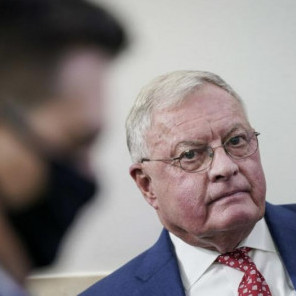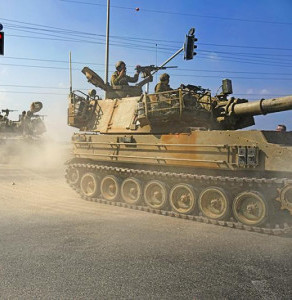Over the past few days, Ukraine has been flooded with final opinion polls on the first round of the presidential elections. Final as their publication stops on Friday under the law. Their results coincide on one key point – the comedian Vladimir Zelensky is the frontrunner and boasts a clear lead in almost all of them. On another key point, sociologists are split, with one part giving the second spot to incumbent President Pyotr Poroshenko, while the other – to twice former prime minister Yulia Timoshenko. The latter represent a smaller part, though a solid minority.
Putting aside the data provided by both no-name pollsters and those who have long made little secret of their partisanship (usually to the advantage of the head of the state), a controversy persists. Let’s take the latest surveys conducted by two most reliable pollsters, Kiev International Institute of Sociology (KIIS) and Rating Group. The former suggests that 27.6% of those who plan to cast votes in the elections and have made their choice, are ready for vote for Zelensky, 18.2% - for Poroshenko, whereas Timoshenko’s gap with the second place is far from the polls' margin of error (12.8%), with the candidate from the "Opposition Platform For Life" party Yuri Boyko close on her heels (11.1%). Meanwhile, according to Rating, Zelensky scores 26.6%, Poroshenko goes stride-for-stride with Timoshenko with 17.2%, and none of other candidates makes it to 10%, whereas Boyko with 9.5% even trails former Defense Minister Anatoly Gritsenko by 0.3%. Consequently, the data provided by that pollster shows that after the first round Poroshenko may drop out of the race and Ukraine will have a new president, while KIIS suggests that such an outcome of the voting is unlikely.
Both public opinion gatherers also offer various support dynamics demonstrated by top three candidates. Particularly, if their current data is compared with previous surveys also conducted in March, Rating suggests that Zelensky gained 1.7%, whereas both his followers lost: Poroshenko – 0.2% and Timoshenko – 1.6%. It is the opposite with KIIS: Zelensky slipped 4.5%, while his contenders slightly boosted figures – Poroshenko by 1.1% and Timoshenko by 0.3%.
However, some factors can make the reality differ from surveys. Specifically, Yulia Timoshenko in 2010 presidential elections and its Batkivshchina (Fatherland) Party in parliamentary elections in 2002, 2006, 2007 and 2012 demonstrated far better results that surveys forecasted. Nevertheless, neither presidential nor parliamentary (Verkhovna Rada) elections in 2014 confirmed the trend.
On the other hand, the credit of Pyotr Poroshenko’s result is due to his position. The advantages of incumbency can be expected to provide him with an absolute majority of votes at closed polling places (jails, military units and the like) and other privileges, as was the case with his predecessors.
Nonetheless, the experience has shown that results of the candidate set up by the state and parties of the state at Ukrainian elections have never been notably better than the results of surveys. Not all respondents dare to be frank with sociologists (in today’s Ukraine there are more such people than before the war), and even the last-minute choice of undecided voters was usually against the power. For example, Pyotr Poroshenko had the strongest disapproval rating, and he trails many politicians as a second choice option. My understanding is that various data on candidates’ support provided by Rating and KIIS in no small part is related to the fact that the number of undecided voters is higher with the latter pollster (traditionally for it) compared with the former.
Moreover, over the past few days, the widely spread view has been that the key point is not to let Poroshenko run for the second round, and since Zelensky will pass anyway it is necessary to keep the support of non-rating candidates until the parliamentary election, whereas now – to vote for Timoshenko no matter the odds. That idea is widely disseminated in social networks by quite a few popular bloggers, one of them is former Minister of Justice under Yanukovich Olena Lukash. Finally, pensioners are the most disciplined voters, and in this age group, Timoshenko enjoys the highest support share. Whereas Pyotr Poroshenko’s biggest voter base is among adults who caught the time of perestroika and declaration of Ukraine’s independence as young people. Nevertheless, they are also quite active voters.
However, though Rating says that Vladimir Zelensky has gained in all age groups, he is only on the fifth spot among voters aged 60 and over, and follows both Poroshenko and Timoshenko among voters aged 50-60. He is the frontrunner, though by a slight margin, in the group of voters aged 40, and an undisputed leader in two youngest age categories. Particularly, 40% of all interviewed Ukrainians under 30 are ready to vote for him. KIIS’s division of the society by age groups is slightly different, though the picture in principle is very similar.
However, the record shows that young people are less active at elections and prefer to vote in the second half of the day. Which means that theoretically a situation may occur that when the main voter for Zelensky is only preparing to go to the polling station the results of exit polls among those who have already voted will be already made public. And if they show a notably lower result of the comedian than suggested by surveys on the election eve, that could discourage his voters who keep a close eye on sociology.
Indeed, the law prohibits such publications, though in the past the ban was easily skirted. For example, on the day of the first round of 2010 election the current Deputy of Verkhovna Rada Mustafa Nayyem released the ratings of strong drinks, though it was obvious for any reader that ‘vodka’ meant Viktor Yanukovich, ‘Chacha’ – Yulia Timoshenko (causing a scandal with lots of Georgian observers), ‘honey beer’ – bee-keeping Viktor Yushchenko and so on.
That said, Zelensky’s advance is such that the described circumstances can lower his result, but can hardly move him from the leading position. It should also be noted that many forecasts regarding voters’ attitude to him have never realized. Particularly, misplaced has become the opinion (which I shared as well) that the candidate’s movie and ‘Club of the cheerful and sharp-witted’ image will be insufficient for the voter base, and he will disappoint when talking about particular problems of people. A survey conducted by KIIS revealed a paradoxical picture. Respondents were asked whether they are aware of their candidates’ proposals on 12 main issues of the domestic and international policy. As a result, Zelensky’s constituency turned out least of all informed compared with the constituency of other presidential candidates. Which not at all frustrated his leadership. He attracts his voters as a personality, first, and second, due to the fact that he does not belong to the current power. That is sufficient for them.
Besides, there are circumstances that, on the contrary, can enable Zelensky to stretch his lead. Specifically, now surveys show that the majority of voters (relative though) believe that he is the one to have the upper hand, whereas a certain category of the votership can cast votes for the frontrunner at the last moment. Moreover, over the past several days the 1+1 national TV channel owned by oligarch Igor Kolomoisky has been broadcasting another series of the comedy drama ‘Servant of the People’, in which Zelensky plays people’s president Vasiliy Goloborodko, and that was the comedy series that has become the starting point for the candidate’s approach to the politics. Whereas on the ‘pre-election silence’ day on March 30 the same channel will broadcast comic programs with his participation all the time.
Finally, it may prove to be the case that sociology underreported the level of his virtual support due to incorrect selection. For example, the fact that interviewed respondents should reflect the country’s population is a fundamental truth. Consequently, the number of respondents from western regions should stack up to the number of respondents from eastern ones in the same way as the numbers of voters from those regions relate to each other. That said, sociologists can only manipulate the data of the Central Election Commission on the approximate number of voters. However, neither the Central Election Commission nor anyone at all know how many Ukrainians work abroad, only occasionally coming back home. Though many millions are at stake. And there are more such voters in western regions. Consequently, if the scale of voting under alien passports is curbed, the share of southeastern pollers among voters will turn out higher than predicted by surveys. That circumstance would have played into the hands of Timoshenko in competition with Poroshenko as she slightly surpasses him in those regions, but first of all would provide Zelensky with an extra bonus since he is most of all supported in southeastern regions.
However, age distinctions are much more notable than regional ones in the voting base of the election race’s frontrunner. And though in western areas he is slightly behind his key competitors the level of his support is far higher there than Viktor Yanukovich had. Zelensky can not at all be called a southeastern candidate in the sense traditionally used in Russia. True, he demonstrates neither nationalism, nor warlike attitude, but is not directly criticizing the authorities’ humanitarian policy or their approach to the Donbass conflict. Meanwhile, only each eighth voter for Zelensky expects him to ensure peace in Donbass. Those figures show that Ukraine has so much got accustomed to the war by the end of its fifth year that it is not a very worrying issue.









